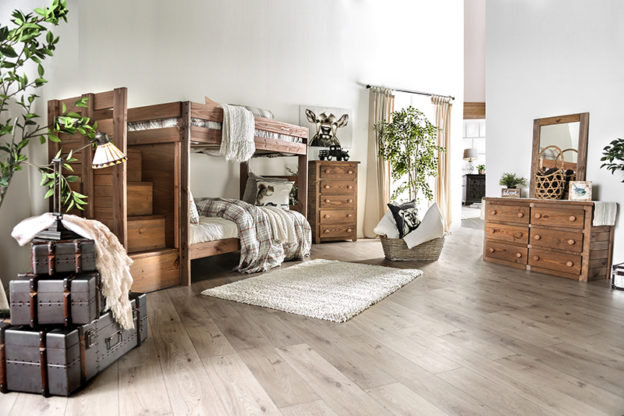Post by FOA Team
This was written as a quick guide to some of the most common woods you’ll encounter around your home or in the furniture store. Hopefully you can use it as a reference sheet for your next furniture purchase.

This rustic styled bunk bed is an unadorned beauty made from pine wood.
Pine
Pine is an inexpensive, lightweight wood that can be found in any U.S. home improvement store. It typically has a yellow or white hue with brown to dark brown knots. It is used every day, everywhere. It is also used in construction and historically as a secondary wood.
Pros: It’s the lowest-costing wood used for furniture making and takes paint well. So it’s great for kids’ furniture. Reclaimed pine has become very popular for reuse in rustic looking pieces as a great way to reuse a natural resource. Pine resists shrinking and swelling.
Cons: It’s softwood, so it’s prone to scratches and dents. The knots can also bleed through the paint. If purchased, sometimes pine can still contain sap that gums up your tools. Pine doesn’t stain too well.

This armoire will add that trendy mid-century appeal to your bedroom.
Maple
Maple is white hardwood that sometimes has a reddish tinge. One of the hardest wood species, maple is used in bowling alleys as a testament to its ability to withstand heavy use.
Pros: Maple is affordable and readily available in a variety of grades, each of them highly durable. It is absolutely tough and can take a lot of abuse, hence why it’s used in cabinets. Takes dark stains well, allowing it to mimic a pricier wood, like mahogany, at a fraction of the price.
Cons: Maple must be sealed properly or the staining will look spotty. Maple lacks grain variation which amplifies the appearance of scratches.

Dining chairs designed with mission-inspired backs and padded fabric seats.
Cherry
Cherry is a hardwood with a fine, straight grain that is coveted for its color and quality. It is often used for carved chairs but also shows up in clean-lined Shaker-style tables and cabinets. The grain in cherry is varied, with pin knots, curls, random swirls and gum streaks.
Pros: It’s easily shaped and used in traditional style furniture. Cherry wood can take a variety of finishes and polishes well. Unstained, it has a rich, beautiful color.
Cons: It’s expensive. Cherry wood reacts to sunlight, changing the color unpredictably. Will darken with age and bring out the grain, depending on your view it can be a pro or a con. While a hardwood it is not as resilient as oak or hickory.

This ladder back chair is rich and rustic, offering comfort with angled back rests.
Walnut
Walnut is a hardwood with a very straight-grain that is prominent and stunning. Often finished with a clear coat or rubbed oil because of its coloration.
Pros: Walnut is a stable wood that can handle intricate carving because of its strength and chipping resistance. It has a lavish color that doesn’t need staining or paint, perfect for a natural look.
Cons: It’s expensive. The color variation in a single piece can be off putting to anyone that wants consistency. American Walnut is softer than its Brazilian counterpart, making it more prone to scratches.

Celebrate the most festive occasions with this wine cabinet.
Oak
Oak is one of the oldest types of wood, with a long history of quality. Oak furniture is coveted for its ability to last for centuries. It is a hardwood that a high amount of grain. There are two varieties: red oak and white oak. Oak is high quality and the top choice for many homeowners.
Pros: Oak is extremely durable and warp resistant, allowing it to age gracefully and withstands the test of time. Because of its visible wavy grain, it has a distinctive look. A clear finish nicely highlights the grain.
Cons: Staining oak exaggerates its grain, which can be visually off putting to some. Despite being a hardwood, it scratches easily, making it unsuitable for children or pets. Sunlight and moisture are a concern. Sunlight will alter the coloring, and moisture will spoil the grain. Wipe away any spills as soon as they happen. Oak is heavy, any moving of furniture will require some help.


Nice but i wont new style 2016